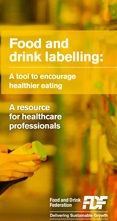Nutrition labelling – back or side of pack information
Within the new EU regulations it will be mandatory for food and drink
manufacturers to provide nutrition information on almost all food and drink [10]; this is usually found on the back of product packaging (and sometimes the
side).
Nutrients will be required to be listed in a certain order – energy (both in kilojoules and kilocalories) and the amounts (in grams) of fat, saturates, carbohydrates, sugars, protein and salt (in place of ‘sodium’ which is no longer permitted). This will usually be found in the form of a table – see an example below.
| Typical values | Per 100 grams | Per half a pizza | %RI per half pizza |
|---|---|---|---|
| Energy |
1205 kJ |
1865kJ |
22% |
|
290 kcal |
445 kcal |
22% |
|
| Fat |
11.8g |
18.3g |
26% |
| Saturates |
5.4g |
8.3g |
42% |
| Carbohydrate |
29.4g |
45.5g |
18% |
| Sugars |
3.8g |
5.9g |
7% |
| Protein |
14.2g |
21.9g |
44% |
| Salt |
1.9g |
2.9g |
48% |
This information has to be given per 100g/ml of the food or drink but can
additionally be given:
- Per portion or per consumption unit (e.g. per slice)
- As a % of Reference Intakes (formerly known as Guideline Daily Amounts)
Information on the following nutrients can be provided in a voluntary basis: mono and poly-unsaturated fats, polyols, starch and fibre. Information on certain vitamins and minerals can be given if listed on an approved list and present in significant amounts[11].
If claims are made as to the nutritional content or health of the product it becomes mandatory to give information about that nutrient in addition to the mandatory ones mentioned above. For example, if the claim ‘high in omega 3’ was made then the amount of omega 3 per 100g would have to be shown.
Last reviewed: 22 Jul 2016
